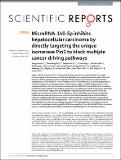| dc.contributor.author | Yan, Xingxue | en_US |
| dc.contributor.author | Zhu, Zhendong | en_US |
| dc.contributor.author | Xu, Shenmin | en_US |
| dc.contributor.author | Yang, Li-nan | en_US |
| dc.contributor.author | Liao, Xin-Hua | en_US |
| dc.contributor.author | Zheng, Min | en_US |
| dc.contributor.author | Yang, Dayun | en_US |
| dc.contributor.author | Wang, Jichuang | en_US |
| dc.contributor.author | Chen, Dongmei | en_US |
| dc.contributor.author | Wang, Long | en_US |
| dc.contributor.author | Liu, Xiaolong | en_US |
| dc.contributor.author | Liu, Jingfeng | en_US |
| dc.contributor.author | Chen, Ruey-Hwa | en_US |
| dc.contributor.author | Zhen Zhou, Xiao | en_US |
| dc.contributor.author | Ping Lu, Kun | en_US |
| dc.contributor.author | Liu, Hekun | en_US |
| dc.date.accessioned | 2017-05-01T19:27:34Z | |
| dc.date.issued | 2017 | en_US |
| dc.identifier.citation | Yan, X., Z. Zhu, S. Xu, L. Yang, X. Liao, M. Zheng, D. Yang, et al. 2017. “MicroRNA-140-5p inhibits hepatocellular carcinoma by directly targeting the unique isomerase Pin1 to block multiple cancer-driving pathways.” Scientific Reports 7 (1): 45915. doi:10.1038/srep45915. http://dx.doi.org/10.1038/srep45915. | en |
| dc.identifier.issn | | en |
| dc.identifier.uri | http://nrs.harvard.edu/urn-3:HUL.InstRepos:32630598 | |
| dc.description.abstract | Hepatocellular carcinoma (HCC) is the second leading cause of cancer related-death. As a major common regulator of numerous cancer-driving pathways and a unique therapeutic target, the prolyl isomerase Pin1 is overexpressed in a majority of HCCs, whereas the mechanism underlying Pin1 overexpression remains elusive. Here we find that miR-140-5p inhibits HCC by directly targeting Pin1 to block multiple cancer-driving pathways. Bioinformatics analysis, miRNA binding and functional assays identify that miR-140-5p directly interacts with the 3′UTR of Pin1 and inhibits Pin1 translation. Furthermore, like stable Pin1 knockdown, moderate overexpression of miR-140-5p not only eliminates Pin1, but also inhibits cells growth and metastasis. Importantly, these effects of miR-140-5p are largely rescued by reconstitution of Pin1. Moreover, miR-140-5p inhibits multiple Pin1-dependent cancer pathways and suppresses tumor growth in mice. The clinical significance of these findings has been substantiated by the demonstrations that miR-140-5p is frequently down-regulated and inversely correlated with Pin1 overexpression in HCC tissues and cell lines. Given prevalent miR-140-5p downregulation in other cancers and major impact of Pin1 overexpression on activating numerous cancer-driving pathways including global miRNA downregulation, the miR-140-5p/Pin1 axis may play a major role in tumorigenesis and offer promising therapeutic targets for HCC and other cancers. | en |
| dc.language.iso | en_US | en |
| dc.publisher | Nature Publishing Group | en |
| dc.relation.isversionof | doi:10.1038/srep45915 | en |
| dc.relation.hasversion | http://www.ncbi.nlm.nih.gov/pmc/articles/PMC5382892/pdf/ | en |
| dash.license | LAA | en_US |
| dc.title | MicroRNA-140-5p inhibits hepatocellular carcinoma by directly targeting the unique isomerase Pin1 to block multiple cancer-driving pathways | en |
| dc.type | Journal Article | en_US |
| dc.description.version | Version of Record | en |
| dc.relation.journal | Scientific Reports | en |
| dc.date.available | 2017-05-01T19:27:34Z | |
| dc.identifier.doi | 10.1038/srep45915 | * |
| dash.authorsordered | false | |


